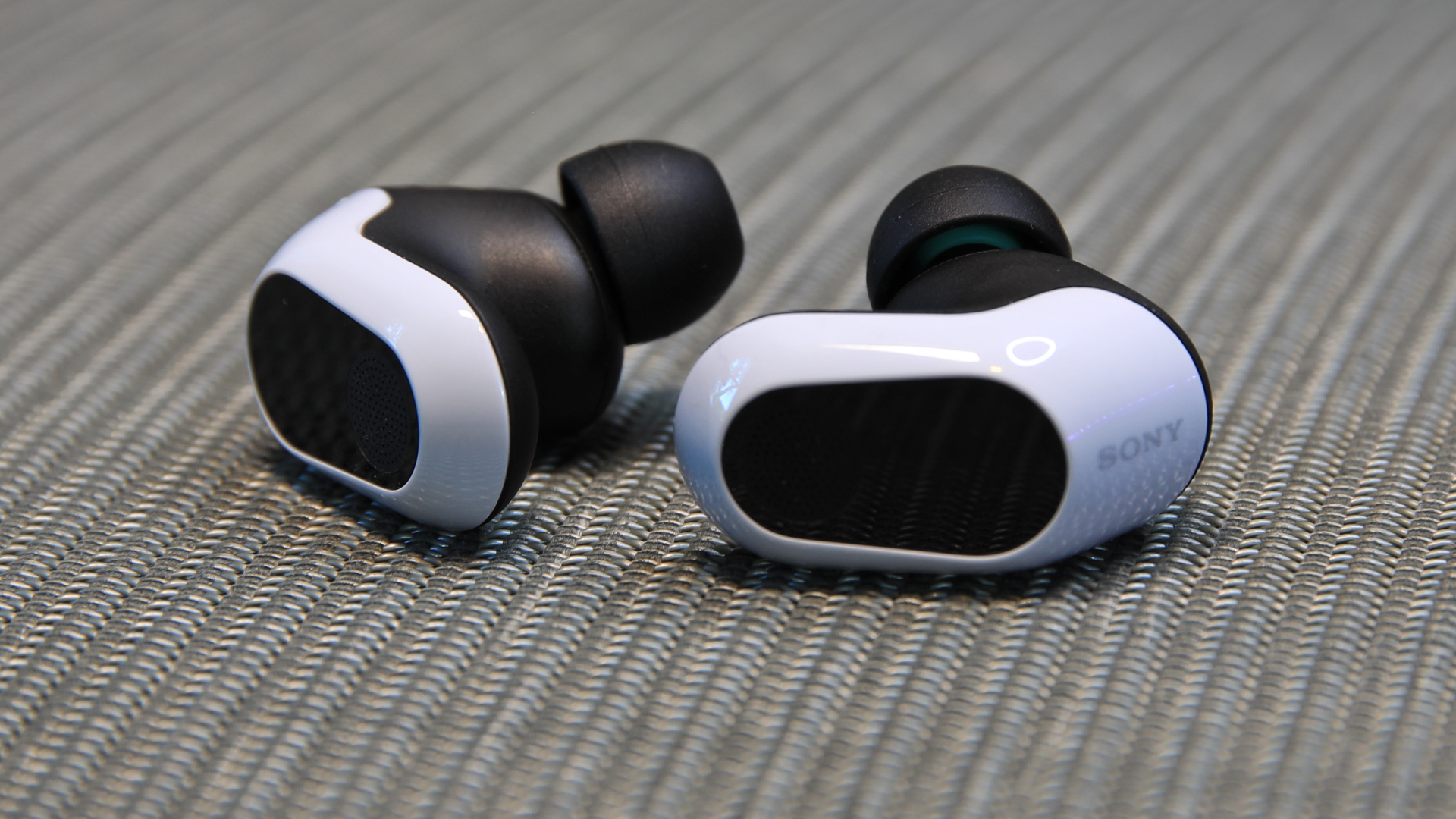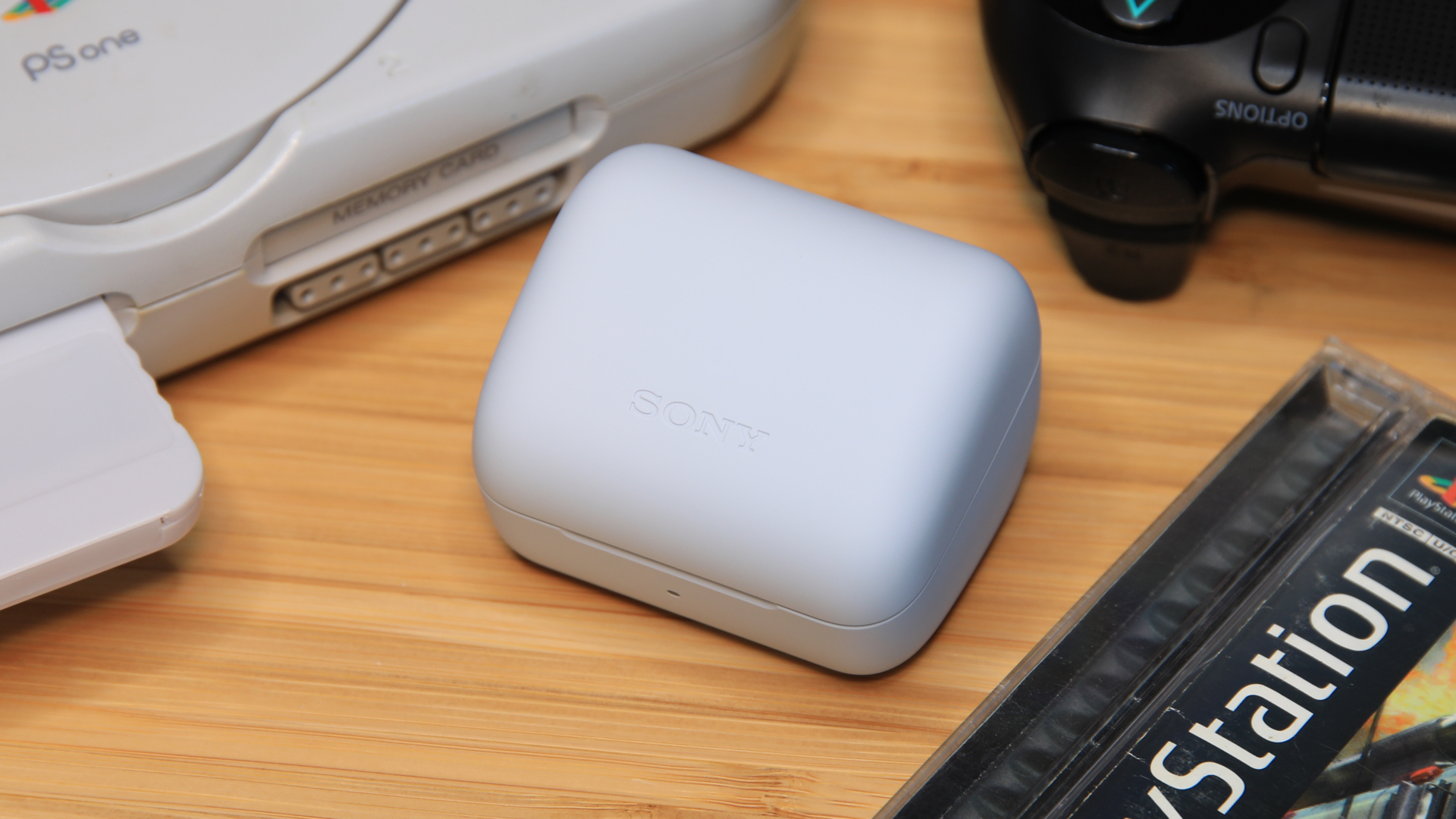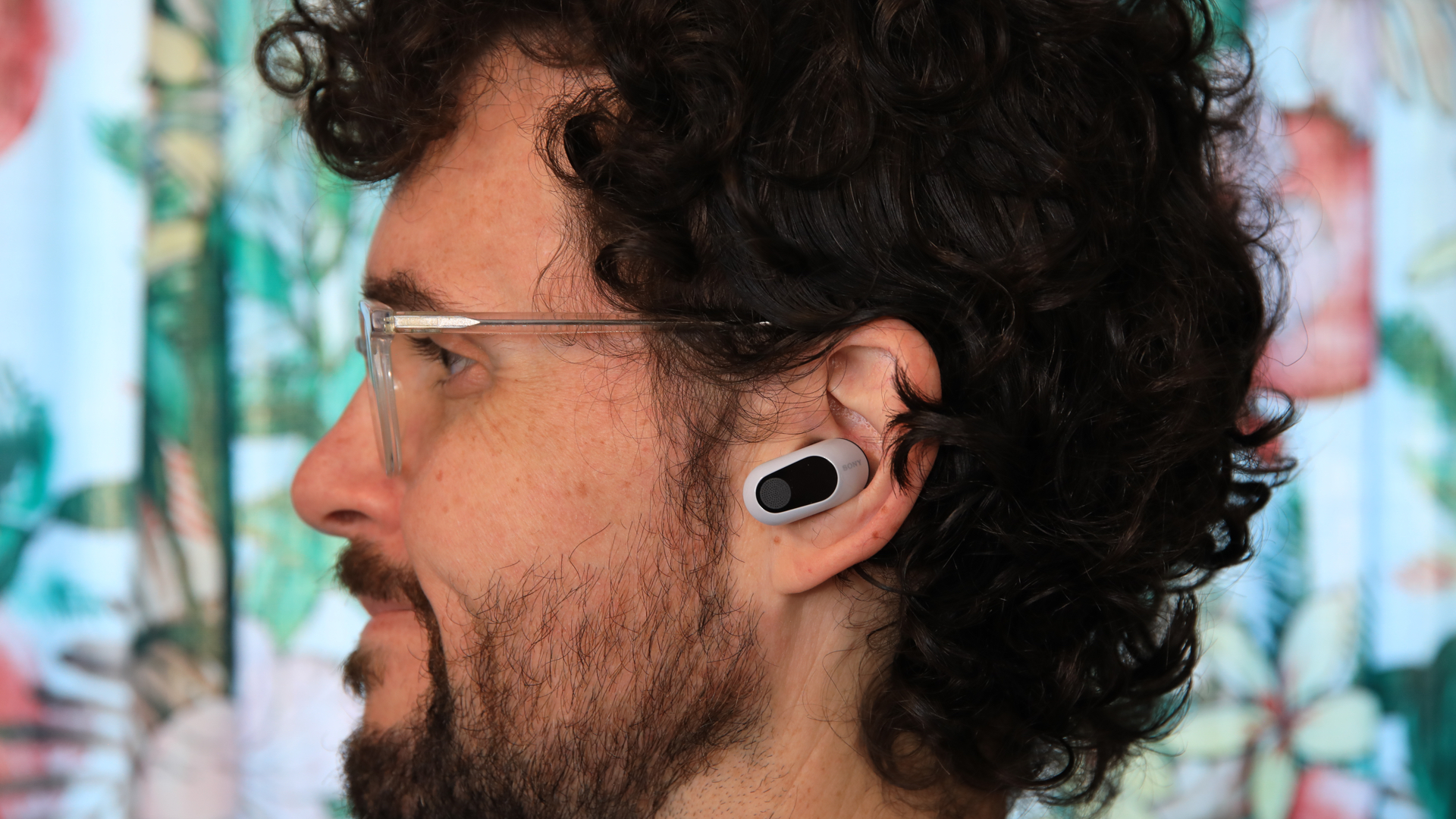Tom's Hardware Verdict
Superior sound quality, ANC, and battery life make Sony’s InZone Buds a winner.
Pros
- +
Excellent audio quality
- +
Fantastic active noise cancellation
- +
Attractive design, comfortable fit
- +
Long battery life
Cons
- -
Spotty device compatibility
- -
Spatial Sound failed to impress
Why you can trust Tom's Hardware
Sony usually keeps a low profile in the gaming peripheral arena, focusing mainly on PlayStation-compatible hardware. That’s changing, however, with Sony’s InZone “gaming gear” sub-brand, which includes PC-compatible monitors, headsets, and, now, the Sony InZone Buds.
The gaming-oriented InZone Buds build on the company’s experience with wireless earbuds, like the well-regarded WF-1000XM5, to deliver punchy audio and excellent noise cancellation. Earbuds still have a ways to go before they can compete with the best wireless gaming headsets, but the InZone Buds are making a good case for it.
| Driver Type | Sony Dynamic Driver X, 8.4mm |
| Impedance | Unlisted |
| Frequency Response | Unlisted |
| Design Style | Earbuds |
| Microphone Type | Built-in |
| Connectivity | 2.4GHz wireless (USB-C dongle), Bluetooth |
| Weight | 0.23oz / 6.5g |
| Cord Length | 6 inches, USB-C |
| Battery Life | 12 hours (2.4GHz wireless) 24 hours (Bluetooth) Charging case provides an additional 24 - 48 hours |
| Lighting | None |
| Software | Sony InZone Hub (Windows) |
| MSRP / Price at Time of Review | $199.99 |
| Release Date | Oct. 15, 2023 |
Design and Comfort
The Sony InZone Buds embrace the spacey, curvacious, white-and-black design language introduced by the PlayStation 5 — and it works well. A black colorway is also available for those who want a more subtle look, but the white-and-black design is conservative enough that it won’t look out of place in an office. Gamers will recognize their PlayStation heritage, but everyone else will assume they’re run-of-the-mill Sony earbuds.
The earbuds’ conservative look means RGB lighting isn't on the list of features. Whether this matters is up to you: I’ve never cared much for lighting on earbuds or headsets, but streamers looking for flair may be disappointed — and many similarly-priced competitors, such as the Razer Hammerhead Pro HyperSpeed, do have lighting.
Sony’s design experience really comes through in one critical area: comfort. Comfort is subjective, but I found the InZone Buds to be very pleasant to use while still being stable in my ears.
The earbuds come in a charging case shaped like a treasure chest. The case is larger and more rectangular than most, which makes it hard to pocket. That said, this design does have some advantages — for example, the case easily sits flat on a desk or entertainment cabinet. The USB-C charging port is located on the back of the case so that the cable, when attached, exits directly from the rear of the case, which makes for easy cable management. The case also has room to stow the earbuds' included USB-C wireless dongle.
It’s a shame, however, that the included USB-C cable is comically short at just six inches long. It did the job, I guess, but it left the otherwise well-designed charging case dangling off the side of my PC. The USB-C charging port offered good clearance, at least, so most USB-C cables will work with the case.
Get Tom's Hardware's best news and in-depth reviews, straight to your inbox.
Sony also provides four additional pairs of earbud tips (for a total of five) and a rod to hold them. This was a nice touch, as most wireless earbuds just toss the tips into a small plastic bag that’s difficult to sort through.
Audio Performance
Sony arguably has more experience building headphones and earbuds than just about any company on the planet, and the InZone Buds are a clear product of this experience.
I started my testing with Boards of Canada’s New Seeds, a nuanced track that slowly builds towards a complex climax. The InZone Buds were stellar in this track, providing excellent separation and clarity among highs, lows, and mids, which is crucial for picking up the track’s details. I also noticed a warm, analog feel that was suited to the artist’s retro-future sound.
The InZone Buds’ warmth was similarly useful in Taylor Swift’s Anti-Hero, a track that builds on retro vibes for a cozy yet creepy presentation. Thick, all-encompassing bass provided the perfect backdrop for Swift’s clear, crisp vocals, which cut through like a knife.
DJ Shadow’s Nobody Speak (ft. Run The Jewels) was another winner with these earbuds — though for different reasons. The InZone Bud’s bass was a tad underwhelming, but taut, and the track’s saxophones moved into the soundstage with ease. I noticed significant detail and nuance to the saxophones, as well, which delivered a more realistic feel than most competitive gaming earbuds.
Yves Tumor’s Echolalia was the only test track that left me a bit cold. This artist has a harsh electric style that felt dampened by the InZone Buds’ warm, soupy delivery. It was still enjoyable, but the earbuds seemed to sand down the edges — and this lessened this particular track's impact.
The Sony InZone earbuds also sounded great in games thanks to their impressive detail. The earbuds delivered a clear, defined, and reasonably wide soundstage — for gaming earbuds, at least — with enough room for sound effects and music to play without one immediately overwhelming the other. This is a major benefit in modern shooters, role-playing, and action-adventure games, all of which tend to throw big, bass-heavy explosions alongside dialogue and detailed background music.
Starfield gave the InZone Buds a chance to shine. The recently-launched RPG has a lovely soundtrack, excellent sound effects, and tons of dialogue, but its freeform nature often results in a hectic presentation — with NPCs chattering behind waves of dramatic music and the repetitive tat-tat-tat of gunfire. All of these sounds came through clearly on the InZone Buds, with no single element dominating. It was especially noticeable in the game’s cities, where the constant NPC batter is often difficult to hear on less-capable earbuds and headsets.
It was a similar story in Horizon: Forbidden West. Aside from the elements I mentioned in Starfield, this game also includes wide, grating bass effects from the part-biological, part-machine monsters. The InZone Buds handled these effects well — they sounded punchy, yet crisp.
That’s not to say the InZone Buds were perfect. A lack of oomph to deep bass is a common issue for earbuds, and gaming earbuds in particular. The InZone Buds were better than average, but still felt weak when huge, rumbling explosions shook the screen.
Surround sound — another common weakness in earbuds — also failed to impress. The earbuds support Spatial Sound (after a multi-step process that includes photographing your ears — really!), but the results were very modest. While I noticed a good separation of left, right, up, and down, the sound stage didn’t seem to reach behind my ears.
I also need to call out Sony’s lack of clarity about how Spatial Sound should function in games. The multi-step setup process claimed to provide the best listening experience, but it offered no information about how the feature (which is turned off by default) should sound, or how it should be used in games. I suspect many less tech-savvy owners won’t even realize the feature exists.
Microphone
The InZone Buds have a built-in microphone that can’t be removed. It performed well for a built-in earbud mic, but it suffered from some common issues.
The microphone definitely sounds like an earbud microphone. It had a distant, muffled quality that made recorded audio sound like I was talking to someone on speakerphone, especially compared to a higher-quality headset mic. The microphone’s subdued presentation had trouble cutting through chatter.
That said, microphone quality was good enough — your friends on Discord won’t have trouble understanding you — and benefited from Sony's AI noise cancellation. The microphone picked up louder, less repetitive noises, but it almost entirely removed the sound of my mechanical keyboard while I was talking on Discord — something most earbuds don't achieve. More distant sounds, such as a loud conversation in an adjacent room, also weren't picked up.
Features and Software
The InZone Buds have Sony's top-tier active noise cancellation, and it's easily the earbuds' best feature.
Placing the InZone Buds’ ANC in my ears was like putting a thick, warm, cozy blanket over my head. Nearly all sounds were reduced or even entirely obscured, from the rustle of wind through the trees in my yards to the distant tap-clack of roofers and the persistent whoosh of a space heater. Even the caws of the crows that hang out near my office were muffled (though still audible).
I can’t stress this enough: Sony’s ANC is in a completely different league than its competition. If you consider excellent ANC a must-have, and the InZone Buds support your gaming device of choice, you can end your journey right now — no competitor even comes close.
The InZone Buds’ features are controlled through a downloadable PC app. The app is attractive and responsive and provides a variety of adjustments, including an equalizer and customization of the earbuds’ touch controls. Sony has strangely decided to forgo making a mobile app for Android or iOS, however, so you can’t change some features while on the go.
Device support is hit-or-miss. The InZone buds officially support the PlayStation 5 and Windows PCs through a 2.4GHz wireless USB-C dongle. The dongle can also work with other devices, including the Nintendo Switch and USB-C smartphones, but not the Xbox Series X. Bluetooth is available but I only managed to pair it with my Android smartphone — the InZone Buds failed to connect with any of my Apple devices (an iPhone 12 Mini, iPad Pro, and Mac Mini) over Bluetooth, and a Sony representative confirmed this was expected behavior. The earbuds also failed to connect to my Switch over Bluetooth.
The InZone Buds have the features and performance to work for both gaming and everyday personal audio, but their software and device support fell short of that goal. The restrictions placed on Bluetooth connectivity were especially strange, and not something I've seen in competitors — nearly all gaming earbuds that support Bluetooth can connect to Android and iOS devices, as well as PCs and Switches, with ease.
Battery Life
The InZone Buds boast up to 12 hours of battery life when using 2.4GHz wireless and up to 24 hours over Bluetooth. This is a significant improvement over most competitors: the Razer Hammerhead Pro HyperSpeed offers a maximum of 6.5 hours, while the Logitech G Fits claim up to 8 hours. The InZone Buds’ charging case lengthens the maximum battery life to 24 hours (over 2.4GHz wireless) and a whopping 48 hours (over Bluetooth).
My experience lived up to these lofty figures. I charged the earbuds only once in a week of use — and since I’m still deep in both Starfield and World of Warcraft: Hardcore, my playtime was higher than average.
Charging was easy — the case provides a full charge in two hours, similar to other wireless earbuds. The charging case itself charges via USB-C, so finding a compatible cable (that's longer than six inches) isn't an issue.
Bottom Line
Sony’s InZone Buds provide an excellent audio experience that puts the competition to shame. They feature industry-leading active noise cancellation, a decent built-in microphone, and significantly longer battery life. Unfortunately, the InZone Buds' plusses are soured by spotty device compatibility. While the earbuds' Bluetooth supports Android phones, most devices — including Apple phones and tablets — can only connect over 2.4GHz wireless using the included USB-C dongle.
That adds caveats to what could’ve been must-have earbuds, but the Sony InZone Buds are an easy choice for gamers who play one a PlayStation 5 or Windows PC. They easily defeat rivals like the Razer Hammerhead Pro HyperSpeed in both audio quality and active noise cancellation.
-
wakuwaku TLDR author:Reply
READ THE BOX/MANUAL/OFFICIAL PRODUCT PAGE. Keep up with the times. You are an author on a tech website that regularly reports on up and coming technology that are supposed to make our lives better.
ConsSpotty device compatibilityBluetooth is available but I only managed to pair it with my Android smartphone — the InZone Buds failed to connect with any of my Apple devices (an iPhone 12 Mini, iPad Pro, and Mac Mini) over Bluetooth, and a Sony representative confirmed this was expected behavior. The earbuds also failed to connect to my Switch over Bluetooth.
The restrictions placed on Bluetooth connectivity were especially strange, and not something I've seen in competitors — nearly all gaming earbuds that support Bluetooth can connect to Android and iOS devices, as well as PCs and Switches, with ease.
Lemme guess. You did not read what the box says. You did not read the manual. You did not read the product page on Sony's website. This is a con yes, but a very justifiable one. I shall quote the official product page:
Smartphone device must be compatible with LE Audio or USB-C® Connection.
https://electronics.sony.com/audio/gaming-audio/all-inzone-headsets/p/wfg700n-w
This product ONLY supports Bluetooth LE audio and the LC3 codec. There is no support for any other Bluetooth audio codec. It is not a restriction. It is by design. This is how they get really good battery life (probably). Note the below is all pure speculation based on what Bluetooth LE audio and the LC3 codec offers.
LC3 codec allows Sony to use a lower bitrate while keeping the same or better quality than SBC, the standard bluetooth audio codec that every device since the dinosaur age supports. Lower bandwidth requirements, combined with only supporting only a single bluetooth codec, plus whatever they use for 2.4ghz low latency audio, helps to reduce complexity, keeps costs down, keeps power usage low and keeps the board as small as possible. Maybe even gaining more space for a slightly bigger battery.
If this is what it takes to get longer battery life out of my buds so be it. Android has rolled out Bluetooth LE audio and LC3 codec support in a lot of the newer phones already. And older phones that still get updates to Android 13 and above should also get LC3 codec support. As long as your phone supports Bluetooth 5.2 and your OEM does not block/remove the feature for... reasons.
Meanwhile Apple iinm may not have released support for Bluetooth LE/LC3 audio devices yet on their iPhones. (Don't quote me on this, Apple is being vague about when will iphones ever support new(?) tech is normal but you can Google it).
Obviously the Nintendo Switch not supporting it makes sense, Bluetooth LE audio requires the device to support Bluetooth 5.2 at minimum. The Switch only supports Bluetooth 4.1.
So if Apple doesn't want to update their iPhones, or maybe even being restrictive about what devices can use the newest tech on their iPhones, is it Sony's fault or is it Apple's fault? If console that is already using outdated tech when it was released, is it Sony's fault? (I do not blame Nintendo, they chose the best platform available to them at a reasonable price point and it paid off) It definitely not a restriction on Sony's side. It is a con for sure for not being able to work on older devices, but it is by NO MEANS FINICKY. -
wakuwaku Reply
it doesn't matter. it had input from a human. a human behind it is responsible.Squander said:The review was obviously written by chatgpt -
dimar Hoping for Sony to create some kind of super comfortable running earphones or headphones with properly working ANC.Reply





